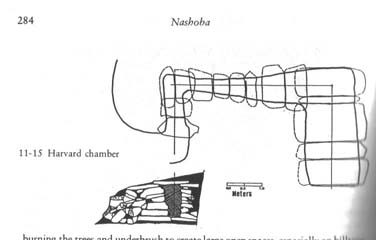 This is a"post and lintel" style of construction with vertical walls, roofed over with large flat slabs. Also, this chamber goes around two right angle turns [and probably used to go around a left hand turn before the entrance], making it very similar to the Acton "Potato Cave", currently being restored in Acton [Click here].
This is a"post and lintel" style of construction with vertical walls, roofed over with large flat slabs. Also, this chamber goes around two right angle turns [and probably used to go around a left hand turn before the entrance], making it very similar to the Acton "Potato Cave", currently being restored in Acton [Click here].Here is the view from outside:
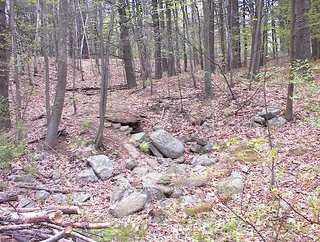 You see the tumbled rocks about the entrance (according to the landowner this part used to be the chamber entrance but it was destroyed by archeologists from Boston -- [College or University?]). You see a small mound of dirt over the entrance and also a larger mound behind and to the right of it - this is the mound over the inner chamber. Here is a head on view of the entrance:
You see the tumbled rocks about the entrance (according to the landowner this part used to be the chamber entrance but it was destroyed by archeologists from Boston -- [College or University?]). You see a small mound of dirt over the entrance and also a larger mound behind and to the right of it - this is the mound over the inner chamber. Here is a head on view of the entrance: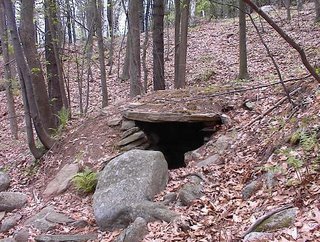 If you poke your head in you see a right hand turn.
If you poke your head in you see a right hand turn.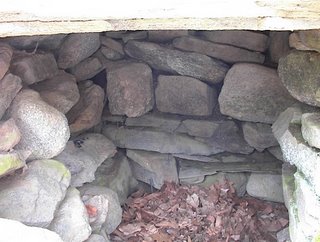 If you go in and look around the corner, you see a long passageway going in deeper. When I first went in, it was too dark to see down the passage but my camera flash showed me enough to guess there was another room at the far end. Also the narrow passage ("only 16 inches wide" according to Mavor) discouraged me from trying to fit my girth down it. The passage is perhaps 10 feet long.
If you go in and look around the corner, you see a long passageway going in deeper. When I first went in, it was too dark to see down the passage but my camera flash showed me enough to guess there was another room at the far end. Also the narrow passage ("only 16 inches wide" according to Mavor) discouraged me from trying to fit my girth down it. The passage is perhaps 10 feet long.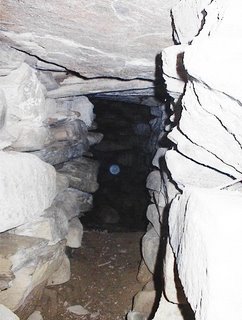 Later on when I came back, my friend from Carlisle went all the way in. He had a flashlight and took pictures of the interior, which have not yet arrived via email. He saw a bat hanging from the roof. While he was in there and I was watching from the entrance he was about a foot lower than I was - so there appears to be significant soil buildup inside this chamber. But with loose cannon archeologists [aka -pot hunters with credentials] mucking about, all bets are off. The thing is, according to the landowner, the archeologists found Indian artifacts inside the chamber. That's news I don't think Mavor and Dix mentioned. It is also the kind of thing which rarely checks out.
Later on when I came back, my friend from Carlisle went all the way in. He had a flashlight and took pictures of the interior, which have not yet arrived via email. He saw a bat hanging from the roof. While he was in there and I was watching from the entrance he was about a foot lower than I was - so there appears to be significant soil buildup inside this chamber. But with loose cannon archeologists [aka -pot hunters with credentials] mucking about, all bets are off. The thing is, according to the landowner, the archeologists found Indian artifacts inside the chamber. That's news I don't think Mavor and Dix mentioned. It is also the kind of thing which rarely checks out.This chamber is located in a what looks like a sand pit - and the landowner said that sand and gravel had been quarried there. This is at the very top of a brook and wetland that hasn't quite started yet but flows away in a southerly direction. The views outward from the chamber entrance are solstice aligned, however you would be in the pitch dark with nothing to look at, if you are in the innermost chamber. With the way the book Manitou is pre-occupied with alignments and sky watching it was surely a puzzle to the authors how this chamber might have been used - deep underground with no view of the sky possible, with three corners and long passages blocking any kind of line-of-site. I am going to go out on a limb here and state my suspicion that thes right hand turns (same with the Acton Potato Cave) have to do with audible phenomena rather than visual ones. I cannot back that up at all and want to finish with the thought that we know noting about these interesting structures. This Harvard one and the one in Acton are unique, in my limited experience. People who have visited more chambers could let me know about this. Surely some real archeology and publications ought to be done here. Luckily, the landowner is very interested in this wonderful structure and perhaps some more studies will be done in the future, and done more carefully.
One more comment about Manitou. I should re-read the pages on Nashoba carefully but it looks like the authors are trying to establish that the "northern" chamber, at the north end of Oak Hill, is in relation to this Harvard "southern" chamber. I don't think so. They are in different styles, the solstice alignment of the Harvard chamber only holds if you are at the entrance looking outward, not in the inner chamber. Also the Harvard chamber is not, in fact, at the southern end of Oak Hill but, several major hills distant from it. If related to anything, this Harvard "cave" is related to the Potato Cave in Acton. Still in Nashoba but part of a not quite so tidy story as given in Manitou.
5 comments :
Perhaps this chamber was used for a kind of sensory deprivation experience, a variation of vision quest in which the suject spends a few days without food, water or even light. After a few days, visions might not be unlikely.
I've been told that there are many variations on methods of seeking inspiration or spirit experiences, not only for the young initiate, but for older people seeking answers to questions or just seeking purification. The method used may have depended on the reason the quest was undertaken. But I know nothing of it first hand.
Our cave was not lost or forgotten, just guarded. Our concern is people damaging the cave or injuring themselves on our property. Kids have partied in there and left garbage. Please, when any of you visit sites on people's private property, come to the door and ask permission. It is disturbing to know someone has been wandering around on our property taking photos without asking first.
We love the cave and its history and are happy to talk about it with you and learn from you.
I am new to this website and am fascinated by all you have discovered. Now I can't drive or walk around Harvard without looking for rockpiles.
As I reread what I wrote , I sound cranky, but I'm not. I just want to protect the cave and the people that want to go inside it.
Good advice. Actually I am going to start obliging myself to ask permission first.
Peter's comment that the chamber might have been built to enhance auditory phenomena is worth investigating further. The four small chambers in Hopkinton, RI, which were discussed earlier on this website, were constructed over an area punctuated with underground streams. There is a large chamber in western MA built in the middle of a stream -- again I feel the sound and presence of flowing water was an important factor in the siting of this feature. And in Rochester, VT, there is a wall nearly 400' long constructed over a culvert-enclosed stream; one can hear the sound of water within the structure, an awesome experience. In all of these sites, the sound factor was paramount, I feel.
Reading your comment I totally understand where you're coming from. Not everybody appreciates these little pieces of History like they should. Would you be possibly open to allowing me to take a quick walk through? If not I, understand. Thank you!
Post a Comment